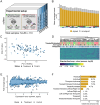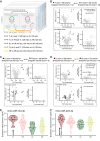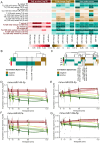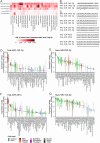Skin treatment with non-thermal plasma modulates the immune system through miR-223-3p and its target genes
- PMID: 38828710
- PMCID: PMC11152102
- DOI: 10.1080/15476286.2024.2361571
Skin treatment with non-thermal plasma modulates the immune system through miR-223-3p and its target genes
Abstract
Non-thermal plasma, a partially ionized gas, holds significant potential for clinical applications, including wound-healing support, oral therapies, and anti-tumour treatments. While its applications showed promising outcomes, the underlying molecular mechanisms remain incompletely understood. We thus apply non-thermal plasma to mouse auricular skin and conducted non-coding RNA sequencing, as well as single-cell blood sequencing. In a time-series analysis (five timepoints spanning 2 hours), we compare the expression of microRNAs in the plasma-treated left ears to the unexposed right ears of the same mice as well as to the ears of unexposed control mice. Our findings indicate specific effects in the treated ears for a set of five miRNAs: mmu-miR-144-5p, mmu-miR-144-3p, mmu-miR-142a-5p, mmu-miR-223-3p, and mmu-miR-451a. Interestingly, mmu-miR-223-3p also exhibits an increase over time in the right non-treated ear of the exposed mice, suggesting systemic effects. Notably, this miRNA, along with mmu-miR-142a-5p and mmu-miR-144-3p, regulates genes and pathways associated with wound healing and tissue regeneration (namely ErbB, FoxO, Hippo, and PI3K-Akt signalling). This co-regulation is particularly remarkable considering the significant seed dissimilarities among the miRNAs. Finally, single-cell sequencing of PBMCs reveals the downregulation of 12 from 15 target genes in B-cells, Cd4+ and Cd8+ T-cells. Collectively, our data provide evidence for a systemic effect of non-thermal plasma.
Keywords: Non-thermal plasma; cell adhesion; miR-223-3p; miRNA; single blood cell sequencing; wound healing.
Conflict of interest statement
No potential conflict of interest was reported by the author(s).
Figures





Similar articles
-
Analysis of Differentially Expressed MicroRNAs in OVA-induced Airway Remodeling Model Mice.Iran J Allergy Asthma Immunol. 2022 Oct 26;21(5):524-536. doi: 10.18502/ijaai.v21i5.11040. Iran J Allergy Asthma Immunol. 2022. PMID: 36341561
-
Identification of the microRNA expression profile in the regenerative neonatal mouse heart by deep sequencing.Cell Biochem Biophys. 2014 Sep;70(1):635-42. doi: 10.1007/s12013-014-9967-7. Cell Biochem Biophys. 2014. PMID: 24756729
-
Exosomal MicroRNAs modulate the cognitive function in fasudil treated APPswe/PSEN1dE9 transgenic (APP/PS1) mice model of Alzheimer's disease.Metab Brain Dis. 2024 Oct;39(7):1335-1351. doi: 10.1007/s11011-024-01395-8. Epub 2024 Aug 1. Metab Brain Dis. 2024. PMID: 39088109 Free PMC article.
-
A unique insight into the MiRNA profile during genital chlamydial infection.BMC Genomics. 2019 Feb 18;20(1):143. doi: 10.1186/s12864-019-5495-6. BMC Genomics. 2019. PMID: 30777008 Free PMC article.
-
Microrna Expression Profiling of Macrophage Line Raw264.7 Infected by Candida Albicans.Shock. 2017 Apr;47(4):520-530. doi: 10.1097/SHK.0000000000000766. Shock. 2017. PMID: 27749761
References
-
- Oehmigen K, Winter J, Hähnel M, et al. Estimation of possible mechanisms of escherichia coli inactivation by plasma treated sodium chloride solution. Plasma Process Polym. 2011;8(10):904–913. doi: 10.1002/ppap.201000099 - DOI
MeSH terms
Substances
Grants and funding
LinkOut - more resources
Full Text Sources
Other Literature Sources
Molecular Biology Databases
Research Materials
Miscellaneous
